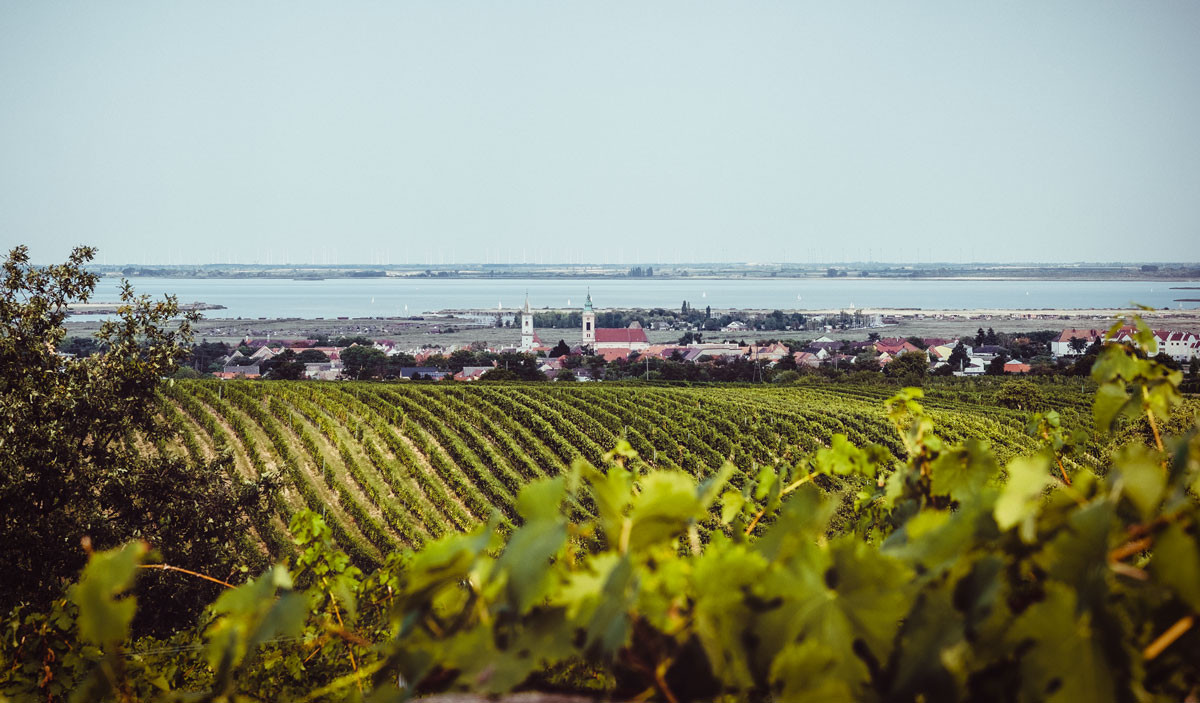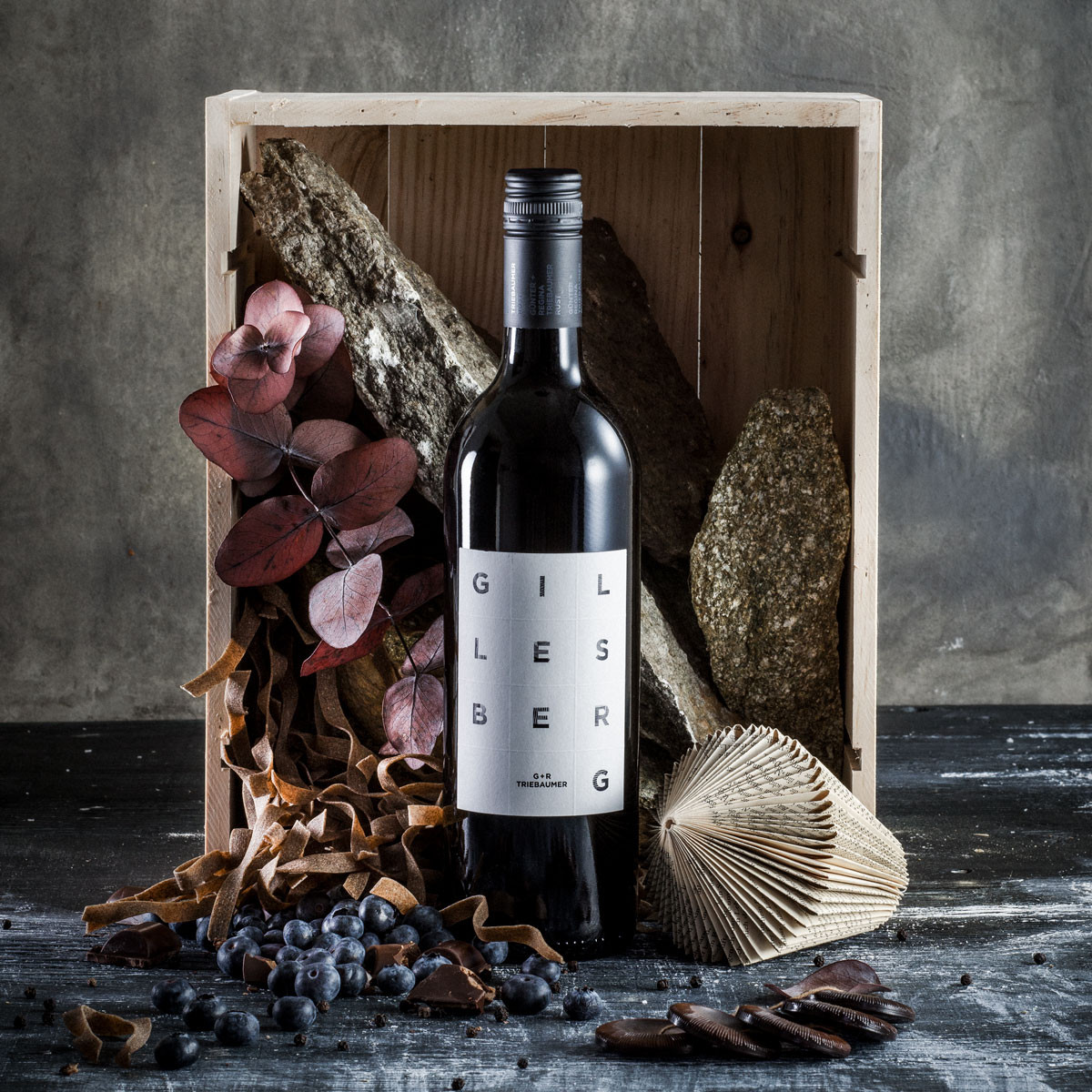Gillesberg – at its best
At the time of the Silesian Wars, the Habsburg Empire under Maria Theresa and her influential advisors decided on a comprehensive army, economic and administrative reform. This also included the first accurate land surveying and cadastral management, the main features of which still exist today.
Since then, the current Cabernet Franc site has contained an old surveyor's stone, cuboid in shape, tapering to a gable at the top. This stone, which is also important to the surveying office in Eisenstadt, marks the highest point of the Ruster Hotter (a hotter is the agriculturally used area of a municipality).
Approximately 30 metres to the east, i.e. in the direction of the lake, there is an orange-painted metal tube with a quartered cardinal point, which represents the current trigonometric survey point. Situated exactly to the west of Rust, the Gillesberg is in many respects an exception.

It cannot be classified in the traditional "five altitude level nomenclature", but lies as the 6th terrace above the Geyer Umriss and the Geyer. The altitude is 181 metres above sea level. That doesn't sound particularly impressive, but anyone who climbs the Gillesberg will arrive at the top gasping for breath. As one of the very few sites in Rust, this vineyard faces north-northeast and is considered very windy. With 1.64 hectares of vineyards, Gillesberg is one of the smallest sites in Rust.
New vines for the land
In the winter of 2021 to 2022, a new, exciting chapter was opened in our favourite vineyard. Praise, thanks, honour and recognition to Hannes Schuster from St. Margarethen, who acquired the last partial parcel in the course of the liquidation of the previous vineyard owner's business and, after some collegial discussions, leased it on to us! And that with sole purchase and exchange option for life plus heirs. Really thrilling! No winner's trophy has ever evoked such emotion. A three-generation project comes to a brilliant conclusion!
Now we quickly got down to work. The old, run-down vineyard as a jubilee vine and others were cleared, 0.4 ha. At the same time, Petit Manseng vines were ordered from the vine nursery we have trusted for many years. Please see this article for the intention and reasoning behind our choice of variety.
Furthermore, in conversation with the extremely active and eloquent main operator of the "St. Georgenrebe" project - Hans Moser, we also planted some vines from the mother vine of Gruener Veltliner on slate weathering soil. Even the Triebaumers can't get much more exciting.
This new plot again has a kind of stepped wedge shape. To prevent too many "bridge rows", we decided to plant a row of pecan nut trees at the westernmost edge. Because in times of walnut mortality - a tragedy in itself - alternatives have to be found here too.
Run forest! Run!
Over the next few winters, the adjoining woodland and bush plots with remains of terraces will be carefully cleared and transformed into a thinly-planted tree slope, sparing the most interesting and healthy trees. On the one hand, this makes it more pleasant to walk through, allows the specific history to be explained more easily and perhaps also enables the one or other semi-legal guerrilla forest viticulture experiment. Here, after all, we still talk of wonderfully structured almost 6,000 m2. Further chapters not excluded!
Maps of vineyards from the 18th and 19th centuries already show the Gillesberg in its present form; it is thus one of the "old vineyards" from a time when the people of Rust earned their special position in the region with sweet wine and skill.
The origin of the name Gillesberg also remains hidden.
In the beginning there was ... Welschriesling
In the 1930s, the then still young grandfather Paul Triebaumer acquired the first area in our top slate site. Until the end of the 1940s, when the vineyards were worked by hand and horse, the site was probably divided into several small terraces and larger in area. Today, the steep, lower part, which slopes down to the „Schafgrube“ to the north, is overgrown with acacia and elder bushes.
On the slopes between the individual plots, small vines grow between the stones, some of which Günter had nurtured in his youth. Varieties include St. Laurent, Zierfandler, Neuburger and Leányka (maiden grape).
When we bought the current Cabernet Franc area from Franz Steiner Senior in 2007, he told us that he had still cultivated terraces after the war, but gave them up when he bought his first tractor. Even after thorough inspection, unfortunately, no more vines could be found on the clearly recognisable gradations in the bushes. Much worse: not a single photo or document exists as proof!
Until the late 1980s, father Paul planted the Gillesberg exclusively with the robust Welschriesling variety, which was also marketed as "Welschriesling Gillesberg" in a dry-fermented variant and was always a distinctive, steely white wine.
The winery's first bottled wine, a Welschriesling Spätlese (late harvest)1976, also originated there. 1979 has always been known as an excellent wine year and from the Gillesberg, from what is today the Syrah area, a 1979 Erstlese Welschriesling Trockenbeerenauslese was pressed - a legendary wine - madeirised today, but still alive due to its supporting acidity.
At that time, the harvesters came from Eisenerz in Styria on the one hand, and from Mör, a Danube Swabian wine-growing community north of Budapest, on the other.
A day of harvesting is unforgettable in the memory of the 13-year-old „Butten“ (wooden grape container) carrier Günter, when Maria , the small but very energetic Hungarian leader of the harvesting team, held up a dried botrytis grape and joyfully exclaimed: "Premium quality" and, as a viticulturist, meant the high quality of the material.

From a viticultural point of view, the "Welschriesling era" was interesting in that these vines were grown on three different types of training systems: the lowest, easternmost plot, where Syrah is grown today, on a cantilever or single-wire culture; the adjoining plot to the west, now planted with Cabernet Sauvignon, on a classic medium-high Guyot training; and even further west, a Vertiko culture with a vertical cordon was used. This third vineyard, planted in 1981, still exists, but was reshaped in the early 2000s to a medium-high Guyot with four pairs of wires and is used almost annually for the production of Ausbruch. Across all varieties applies: the northeast exposure with a magnificent view and constantly cooling winds delays ripening and enhances fruit presence over a prolonged ripening period. The equivalent effect of the clay, which is completely absent here, is thus substituted by climatic characteristics.
The highest part of Franz Steiner's property, who died only two weeks after the sale, was planted, as often, with a Neuburger-dominated Gemischter Satz, which was grubbed up in 2001 due to the desolate support system. Before that, we had already leased the land. After a 7-year regeneration phase with extensive cultivation of clover and legumes as well as oil radish against possible nematodes for soil health, the new planting with Cabernet Franc on Kober 5 BB and the erection of a wire frame made of stainless steel took place.
Wedges, slabs and birds of prey – Gillesberg is different
If you look at the Gillesberg from a bird's eye view, it looks a bit like an obtuse-angled wedge.
At the upper southern end there are currently 27 rows, at the lower end 12. If you wanted to drive through every row without having to reverse, you would need a very sophisticated plan. The respective preparations for planting were correspondingly difficult - the impressions of the Seewinkel vintners oscillated between shock and amazement.
Stones "grow" on the Gillesberg. After each tillage, head-sized boulders come to the surface. If you walk up the northern side, you can see the result of decades of stone picking on the slopes - admittedly, previous generations had more time and leisure to pile up the accumulating stone quantities into dry stone walls, some of which can still be seen today.
In contrast to the Rust sites, such as Vogelsang, Plachen, Kraxner, etc., which stood on Rust gravel, slate rock that was rounded off in the shape of gravel by water transport, there are rather slate layers on the Gillesberg. This speaks for tectonic pressure material, but not for transport. Like all of the hills in front of the main sandstone range of the Rust Hills, the postglacial source material on the Gillesberg consists of slate, which weathered over the course of the last 10,000 years.
When preparing the subplot for planting Syrah, even a 140 HP tractor with a plough reached its limits due to four slate flagstones measuring approx. 150 x 200 x 45 cm, which then had to be recovered by an excavator. No wonder that one of the Welschriesling vine areas always turned yellow while all the surrounding ones remained completely normal green - the yellow ones stood on the "hot stone".
The surrounding vegetation also plays a significant role in this special location. The biotopes consisting of oaks, acacias (=robinias), blackthorn, blackberries, elderberries and rosehip (Hetscherln) serve as habitats for many birds of prey, such as hawks and buzzards. This is precisely why it is appropriate to take more risks with regard to the harvesting time on the Gillesberg instead of costly netting. Obviously, the starlings are aware of the danger and move to large, open vineyards. Due to the wind and balanced growth, the danger of early botrytis is also limited.

In the few places where nutrients can accumulate, wild asparagus may be found with a little luck. In April, such a lot of chervil thrives in these places that one could mow it with a sickle, as well as very juicy nettles. Vineyard peaches also acquire a particularly intense aroma.
Unfortunately, the numerous deer found that out too – but, on the other hand, they go well with the Cabernet Franc!